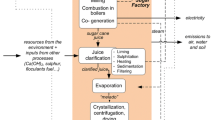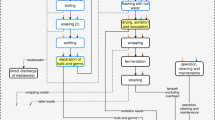Abstract
Purpose
Despite the fact that life cycle assessment (LCA) is a very vital tool, it has not been used in Uganda most likely because very little is known about it. In an attempt to initiate and promote LCA in Uganda, a partnership among Makerere University, selected agro-based companies, and Uganda National Bureau of Standards (UNBS) was initiated with the broad aim of promoting life cycle thinking for improved agricultural products competitiveness on regional and international market. Specifically, the study focused on assessing and quantifying the environmental impacts throughout the life cycle of selected products.
Methods
Life cycle assessment tool was used to quantify environmental impacts including global warming, ecological toxicity, human toxicity, photochemical oxidation, and abiotic depletion. A detailed, process-based gate-to-gate (core process) LCA approach in accordance with ISO 14040, 14044 (ISO 2006a, b), PCR 2012:07 CPC 013 Fruits and nuts together with PCR 2011:08, CPC 2143 Fruit juices was conducted. The functional units have been redefined to; 1 litre of packaged juice ready for consumption and 1 kg of packaged dried fruits including the non-edible parts. Calculations at the farm stage involved calculations of net emission from land cover changes using; ΔC = Ʃ (activity data * emission factor). Calculations of N2O from manure management were obtained.
Results and discussion
Carbon dioxide emissions mainly result from the change of tree cover to crop fields and use of fossil fuel. The other impact categories (ecological toxicity, human toxicity, photochemical oxidation, and abiotic depletion) were brought about by the packaging material used. Results also showed that energy consumption was highest at the agricultural stage of dried pineapples processing and production/factory life cycle stage of sweet bananas. The main challenge during assessment was lack of records.
Conclusions
There is need for avoiding or minimizing the conversion of forest-covered land into agricultural land use due to the high-carbon emissions associated with the change, and for switching to renewable energy sources. There is need for a national database to support LCA efforts.




Similar content being viewed by others
References
Agus F, Subiksa IGM (2008) Lahan Gambut: Potensi untuk Pertanian dan Aspek Lingkungan (peat soil: potential for agriculture and the environmental aspects). Indonesian Soil Research Institute and World Agroforestry Centre (ICRAF), Bogor
Agus F, Gunarso P, Harris N, Schrier-Uijl AP, Malik ARH, Henson IE, Sahardjo BH, Hartoyo ME, Noordwijk M, Brown K, Netzer M, Killeen TJ, Hamzah KA, Joseph KT, Silvius M, Parish F, Lim KH, Rosediana S, Anshari GZ (2013) Reports from the Technical Panels of the 2nd Greenhouse Gas Working Group of the Roundtable on Sustainable Palm Oil (RSPO) Ed: Timothy J. Killeen & Jeremy Goon. Available at: https://rspo.org/publications/download/a2ac85181ed4501. Accessed 8 Jul 2014
Ampaire E, Van Asten JAP, Happy P, Radeny M (2015) The role of policy in facilitating adoption of climate-smart agriculture in Uganda. CGIAR research program on climate change, Agriculture and Food Security (CCAFS), Copenhagen
Basu A, Blodgett C, Müller N (2013) Nationally appropriate mitigation action study on sustainable charcoal in Uganda. United Nations Development Program, New York
Brown S, Grais A, Ambagis S, Pearson T (2012) Baseline GHG emissions from the agricultural sector and mitigation potential in countries of East and West Africa. CCAFS Working Paper no. 13. CGIAR Research Program on Climate Change, Agriculture and Food Security (CCAFS), Copenhagen Available online at: www.ccafs.cgiar.org
Chanaron JJ (2007) Life cycle assessment practices: benchmarking selected European automobile manufacturers. International Journal of Product Lifecycle Management (IJPLM) 2(3):290–311
DEFRA (2006) Environmental impacts of food production and consumption. A research report completed for the Department for Environment, Food and Rural Affairs. Manchester Business School, Manchester
ECA (European Commission for the Environment) (2014) European platform on life cycle assessment (LCA) [online]. Available at: http://ec.europa.eu/environment/ipp/lca.htm. Accessed 06 July 2014
EEA (2000) Emission inventory guidebook: agriculture. European Environment Agency, Copenhagen
EEA (European Environment Agency) (1997) Life cycle assessment (LCA): a guide to approaches, experiences and information sources. Environmental Issues Series no. 6. http://www.epa.gov/nrmrl/std/lca/pdfs/Issue20report20No206.pdf
FOWODE (2012) Gender policy brief for Uganda’s agriculture sector. Forum for women in democracy (FOWODE). United Nations Joint Programme on Gender Equality Availabe at http://www.womankind.org.uk/wp-content/uploads/downloads/2013/06/FOWODE-Gender-policy-brief-for-Ugandas-Agriculture-sector.pdf
Guinée J (2001) Handbook on Life Ccyle Assessment — Operational Guide to the ISO Standards. Editorial in Int J LCA 6(5):255
Guinée J, Gorree M, Heijungs R, Hup-pes H, Kleijn R, de Koning A, van Oers L, Wegener SA, Suh S, Udo de Haes H, de Bruijn H, van Duin R, Huijbregts M (2002) Handbook on life cycle assessment, operational guide to the ISO standards. Kluwer Academic Publishers, Dordrecht
Hoffert MI, Caldeira K, Benford G, Criswell DR, Green C, Herzog H, Jain AK, Kheshgi HS, Lackner KS, Lewis JS, Lightfoot HD, Manheimer W, Mankins JC, Mauel ME, Perkins LJ, Schlesinger ME, Volk T, Wigley TML (2002) Advanced technology paths to global climate stability: energy for a greenhouse planet. Science 298:981–987
Hydro Quebec (2009) Greenhouse gas emissions and hydroelectric reservoirs. Available at: http://www.hydroquebec.com/sustainabledevelopment/documentation/ges.html
IEA Bioenergy (2010) Bioenergy, land use change and climate change mitigation: report for policy advisors and policy makers. IEA Bioenergy:ExCo:2010:03
Ingwersen WW (2012) Life cycle assessment of fresh pineapple from Costa Rica. J Clean Prod 35:152–163
IPCC (2006) Draft 2006, IPCC guidelines for National Greenhouse gas Inventories. Volume 4
ISO (2006a) ISO 14040: environmental management–lifecycle assessment–principles and framework. International Organization for Standardization, Geneva
ISO (2006b) ISO 14044: environmental management–lifecycle assessment–requirements and guidelines. International Organization for Standardization, Geneva
Kaval P (2011) Measuring and valuing environmental impacts. A systematic review of existing methodologies. Network for Business Sustainability, London, Canada
Liamsanguan C, Gheewala SH (2008) LCA: a decision support tool for environmental assessment of MSW management systems. J Environ Manag 87(1):132–138
Lithner D (2011) Environmental and health hazards of chemicals in plastic polymers and products. Ph.D. thesis, Department of Plant and Environmental Sciences. Faculty of Science. University of Gothenburg. ISBN: 978-91-85529-46-9. Available at: https://gupea.ub.gu.se/bitstream/2077/24978/1/gupea_2077_24978_1.pdf
M.A.A.I.F (2011) Ministry of Agriculture animal industry and fisheries, Uganda. Operationalisation of the rural development strategy for increased agricultural productivity
Mogensen L, John EH, Niels H, Randi D (2009) Life cycle assessment across the food supply chain: chapter 5. In: Baldwin C (ed) Sustainability in the food industry. Wiley-Blackwell, Ames
MTTI (2008) National Industrial Policy. A framework for Uganda’s transformation, competitiveness and prosperity. Ministry of Tourism, Trade & Industry, Uganda
Nilsson K, Sund V, Florén B (2011) The environmental impact of the consumption of sweets, crisps and soft drinks. TemaNord 2011:509 ISBN 978-92-893-2197-6
Notarnicola B, Salomone R, Petti L, Renzulli AP, Roma R, Cerutti KA (2014) Life cycle assessment in the agri-food Sector. Case Studies, methodological Issues and Best Practices: ISBN 978–3–319-11939-7, ISBN 978–3–319-11940-3 (eBook). https://doi.org/10.1007/978-3-319-11940-3
Pachauri RK, Reisinger A (2008) Climate change 2007. Synthesis report. Contribution of Working Groups I, II and III to the fourth assessment report
Parish F, Sirin A, Charman D, Joosten H, Minayeva T, Silvius M, Stringer L (eds) (2007) Assessment on peatlands, biodiversity and climate change: main report. Global environment entre. Kuala Lumpur and Wetlands International, Wageningen
PCR (2011) PCR 2011:08 fruit juices (UN CPC 2143). The International EPD System, Stockholm
PCR (2012) PCR 2012:07 fruits and nuts (UN CPC 013). The International EPD System, Stockholm
Phanchandee W, Sachakamol P (2013) Life cycle assessment of mango and mangosteen in Thailand, Proceedings of the 51st Kasetsart University annual conference
Ridoutt BG, Juliano P, Sanguansri P, Sellahewa J (2012) Onsumptive water use associated with food waste: case study of fresh mango in Australia. Hydrol Earth Syst Sci Discuss 6:5085–5114. https://doi.org/10.5194/hessd-6-5085-2009
Rosenbaum RK, Bachmann TM, Gold LS, Huijbregts MAJ, Jolliet O, Juraske R, Koehler A, Larsen HF, MacLeod M, Margni M, McKone TE, Payet J, Schuhmacher M, van de Meent D, Hauschild MZ (2008) USEtox – the UNEP/SETAC toxicity model: recommended characterisation factors for human toxicity and freshwater ecotoxicity in life cycle impact assessment. Int J Life Cycle Assess 13:532–546
Ruviaro CF, Gianezini M, Brãndao FS, Winck CA, Dewes H (2012) Life cycle assessment in Brazilian agriculture facing worldwide trends. J Clean Prod 28:9–24
Sitch S, Brovkin V, von Bloh W, van Vuuren D, Eickhout B, Ganopolski A (2005) Impacts of future land cover changes on atmospheric CO2 and climate. Glob Biogeochem Cycles 19(2):1–15
Sonesson U, Davis J, Ziegler F (2010) Food production and emissions of greenhouse gases. An overview of the climate impact of different product groups. The Swedish institute or food and biotechnology. SIK-report no 802 2010. Available at: http://www.sik.se/archive/pdf-filer-katalog/SR802.pdf
Sonnemann G, Strothmann P, Weyand T, Valdivia S (2016) Opportunities for national life cycle networks creation and expansion around the world. Life-cycle initiative, United Nations Environment Programme. https://www.lifecycleinitiative.org/wp-content/uploads/2016/10/mapping-publication-9.10.16-web.pdf
UIA (2013) Uganda investment authority. Agriculture sector; fruits and vegetables sector profile. Available at: http://www.ugandainvest.go.ug/index.php/2013-10-24-13-08-51/friuts-and-vegetables. Accessed 28 July 2014
Walakira P, Mwanjalolo JGM, Mfitumukiza D, Kaviiri PHD (2013) Carbon footprint initiative in Uganda. Int J Life Cycle Assess 18:743–744
World Economic Forum, African Development Bank and the World Bank (2015) African Competitiveness Report 2015. Chapter 2.1 transforming Africa’s agriculture to improve competitiveness. Geneva: World Economic Forum. Available at: http://citeseerx.ist.psu.edu/viewdoc/download?doi=10.1.1.696.7399&rep=rep1&type=pdf#page=56
Yue C, Hall CR, Behe BK, Campbell BL, Dennis JH, Lopez RG (2010) Are consumers willing to pay more for biodegradable containers than for plastic ones? Evidence from hypothetical conjoint analysis and nonhypothetical experimental auctions. J Agric Appl Econ 42(4):757–772 2010 Southern agricultural economics association
Acknowledgments
We also thank Raul Carlson for the technical support and training in preparation and during the study. We are also grateful to Makerere University, the agro-based companies and Uganda National Bureau of Standards for institutional support that was very crucial for this study.
Funding
We thank Swedish Standards Institute for the funding that enabled us to carry out this study under the “Trade Promotion through Standardisation in the East African Region” project.
Author information
Authors and Affiliations
Corresponding author
Additional information
Responsible editor: Sonia Valdivia
Publisher’s note
Springer Nature remains neutral with regard to jurisdictional claims in published maps and institutional affiliations.
Rights and permissions
About this article
Cite this article
Mfitumukiza, D., Nambasa, H. & Walakira, P. Life cycle assessment of products from agro-based companies in Uganda. Int J Life Cycle Assess 24, 1925–1936 (2019). https://doi.org/10.1007/s11367-019-01629-3
Received:
Accepted:
Published:
Issue Date:
DOI: https://doi.org/10.1007/s11367-019-01629-3




